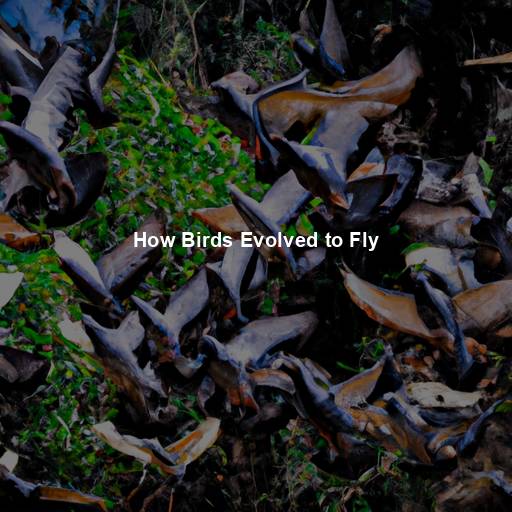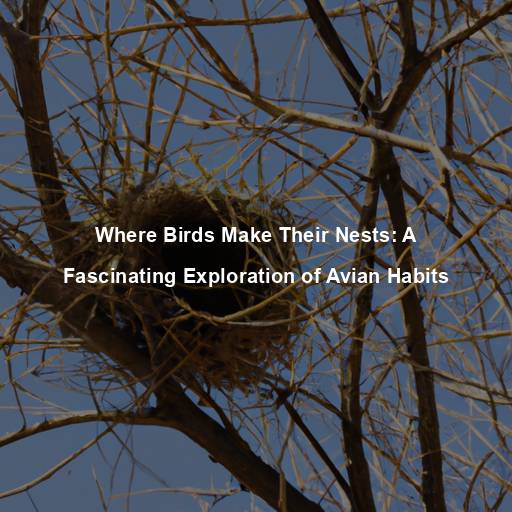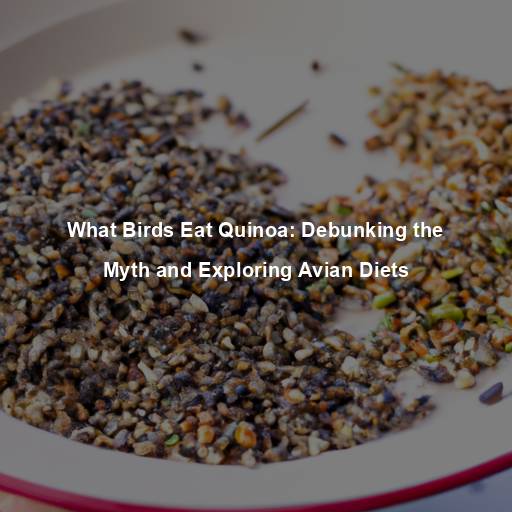How Birds Evolved to Fly
Last Updated on October 28, 2023 by Evan
Contents
- 1 The Fascinating Journey of Avian Flight
- 2 Unraveling the Mysteries of Avian Flight
- 3 Soaring to New Heights
- 4 FAQs for How Birds Evolved to Fly:
- 4.1 What is the process of bird evolution?
- 4.2 How did feathers contribute to the evolution of flight?
- 4.3 What structural changes occurred in the skeleton of birds to enable flight?
- 4.4 How did birds acquire the ability to generate lift and stay airborne?
- 4.5 Were all birds capable of flight throughout history?
- 4.6 Are all birds equally skilled at flying?
- 4.7 Did birds evolve from bats or vice versa?
The Fascinating Journey of Avian Flight
Throughout the eons of time, humans have been spellbound by the captivating allure of birds, as they effortlessly glide and navigate the vast expanse of the sky. The enigmatic marvel of flight, ingrained in their very essence, serves as a testament to their remarkable ability to adapt and endure. Generations upon generations have witnessed the wondrous journey of our feathered friends, from their ancient progenitors to the awe-inspiring array of avian species we behold today. As we venture into the depths of history, we delve into the enigmatic enigma of how birds, against all odds, evolved to conquer the boundless realm of the heavens.
The Early Origins of Avian Flight
Exploring the enigmatic journey of bird flight uncovers a captivating chapter of our distant history. Long before birds graced our skies, their predecessors, the fascinating theropods, prowled the ancient earth during the Late Jurassic era, a staggering 150 million years ago. This peculiar species of bipedal dinosaurs, equipped with nimble frames and adept talons, unknowingly set the stage for the mesmerizing evolution of flight. An intricate tapestry of evolution and adaptation unfurls as we unravel the puzzling secrets behind their delicate dance with the heavens.
The First Steps towards Flight
The key adaptation that set the stage for avian flight was the evolution of feathers. Feathers, originally evolved for insulation and display purposes, gradually became modified for aerodynamic purposes. These early feathers were not yet suitable for flight; instead, they aided in balance and control while climbing and gliding between trees. The ability to glide provided a significant advantage, allowing these early birds to escape predators or reach food sources more efficiently.
Taking to the Skies: Powered Flight Emerges
Travel back in time to the mesmerizing era of the Late Jurassic and Early Cretaceous periods, approximately 150 to 130 million years ago, when the ancient world witnessed the birth of something truly enchanting – powered flight. It was during this captivating time that small, feathered dinosaurs astonished nature’s audience by discovering the astonishing ability to take to the skies. As they evolved, these extraordinary creatures developed an array of specialized body structures that would forever redefine the laws of biology. From a lightweight skeleton to a keeled breastbone (known as the sternum) that served as a launchpad for flight muscles, and the ultimate transformation of their forelimbs into magnificent wings – it was an evolutionary symphony that left even the most astute observers bewildered.
The Advantages of Flight
The ecstasy of soaring through the vast expanse of the sky bestowed birds with unparalleled freedoms. Delighting in newfound liberation, they unfurled their wings to unlock a realm abundant in tantalizing sustenance, evading the clutches of lurking adversaries, and embarking on daring sojourns to far-flung domains. Their audacious exploits flourished as they etched their evolutionary tales, adorning diverse creatures with mesmerizing adaptations and artful flight maneuvers, creating enigmatic stories of survival and triumph.
Wing Shapes and Flight Styles
Birds have evolved a wide range of wing shapes and flight styles, each tailored to their ecological niche. For example, soaring birds such as eagles and albatrosses have long, broad wings that enable them to glide effortlessly for extended periods. On the other hand, agile birds like hummingbirds possess short, rounded wings that allow them to hover and maneuver with exceptional precision. These diverse wing shapes and flight styles highlight the incredible adaptability of birds.
The Role of Feathers in Flight
Feathers, those awe-inspiring marvels of the avian world, are the unsung heroes of flight. With their complex web of interlocking strands, they create a symphony of lift and propulsion, defying gravity itself. These astonishing structures, akin to nature’s own avian aircraft, allow birds to gracefully navigate the elusive art of flight, effortlessly adapting and maneuvering through the ever-changing skies. But their magnificence doesn’t end there – they also serve as a cozy insulation blanket, a mesmerizing display of courtship, and a master of disguise, ensuring birds stay warm, find love, and blend seamlessly with their surroundings.
The Power of Flight Muscles
Behind the awe-inspiring phenomenon of birds in flight lies a crucial element: the flight muscles. These remarkable avian creatures possess a remarkable arrangement of muscles that play a vital role in their airborne endeavors, constituting a substantial portion of their overall body mass. Nestled near the majestic breastbone, these mighty muscles diligently create the necessary propulsion for the enchanting flapping flight we behold. Through a symphony of contractions and relaxations, birds muster the power to generate both the thrust and lift required to gracefully linger in the boundless skies.
The Ongoing Evolution of Flight
The evolution of flight in birds did not culminate in a single design or technique. Instead, birds continue to evolve and adapt their flight capabilities to suit changing environments. Natural selection has shaped the flight characteristics of different bird species over millions of years, fine-tuning their abilities to navigate the skies.
Unraveling the Mysteries of Avian Flight
As we explore the fascinating world of avian flight, we unveil the complexities and marvels of this incredible adaptation. The evolution of flight in birds is a testament to the power of natural selection and the remarkable adaptability of living organisms. By studying the diverse wing shapes, flight styles, and other adaptations in birds, scientists gain valuable insights into the principles of aerodynamics and the mechanics of flight.
A Window into the Past
Delving into the complexities of the avian world, scientists embark on a journey that traverses time, unearthing captivating secrets hidden within the fossilized remains of our feathered friends. It is through the meticulous comparison of long-lost species and their modern counterparts that we are able to decipher the enigmatic puzzle of avian evolution. This ceaseless exploration fuels an insatiable hunger for knowledge, propelling us closer to unraveling the origins of flight and shedding light on the remarkable processes that have molded life on our bewildering planet.
Beyond Birds: Lessons for Human Flight
The allure of avian flight has captivated human curiosity for centuries, providing not only a window into the intricacies of nature but also fueling our ambition to take to the skies. Birds’ breathtaking ability to effortlessly navigate the heavens has been a wellspring of inspiration for the pursuit of soaring among the clouds. Tapping into the enigmatic world of avian flight has yielded valuable insights, infusing our understanding with practical applications that shape the future of aviation. As scientists unravel the cryptic mechanisms behind birds’ graceful airborne adventures, the veil of perplexity lifts, revealing a blueprint for crafting a more sustainable and efficient future for human flight.
The Magic of Flight
As we delve deeper into the intricate mechanics of avian flight, let us not forget to pause for a moment and marvel at the sheer magnificence that takes flight before our eyes. With graceful ease, birds navigate the vast expanse of the sky, effortlessly harnessing the power of air currents. Their flight serves as a poignant reminder of the limitless potential and unfettered liberty that this aerial artistry embodies. In this inexplicable dance of wings, we find ourselves boundlessly inspired and transported beyond the boundaries of our earthly realm, connecting with the ethereal spirits of these winged wonders.
Birds in flight have always captivated our imagination, leaving us in wonder and amazement. The journey they have undertaken to conquer the skies is a perplexing tale of adaptation and survival, filled with bursts of innovation and ingenuity. From their early days as feathered gliders to the vast array of species we witness today, birds have defied the odds through millions of years of evolution. The remarkable diversity in their wing shapes, flight styles, feathers, and flight muscles are a testament to the mysteries of nature, with each unique feature adding another piece to the puzzle of avian flight.
Unraveling the Genetic Secrets
The enchanting realm of avian flight has captivated scientists with its perplexing blend of physical metamorphosis and enigmatic genetic intricacies. Unraveling the enigma of how birds evolved to conquer the heavens has become a tantalizing pursuit for researchers. Delving deep into the intricate tapestry of feather development, wing composition, and muscular architecture, they have managed to illuminate the cryptic secrets encoded within avian genomes, shedding light on the blueprint that empowers these majestic creatures to soar through celestial realms.
Feather Development Genes
Birds are truly remarkable creatures, and one of their most distinctive and awe-inspiring features is their feathers. These intricate structures not only enable them to take to the skies but also serve as a canvas for a stunning array of colors and patterns. Thanks to recent breakthroughs in scientific research, we are now beginning to unravel the intricate genetic mechanisms that govern the development of feathers in birds. Unveiling the secrets behind feather structure, pigmentation, and growth not only leads us on a journey of wonder but also provides us with valuable insights into the remarkable evolutionary history of these extraordinary adaptations.
Wing Formation Genes
The fascinating world of wing development has puzzled scientists for ages. Like a finely choreographed dance, multiple genes come together in harmony, orchestrating the formation of these magnificent structures. Among the genes unraveling this enigma are the masters of limb patterning and bone growth, shaping the delicate wings of avian creatures with utmost precision. Through their exceptional work, these genes empower birds to conquer the skies, their wings embodying the very essence of aerodynamic prowess.
Muscle Structure Genes
It’s truly extraordinary how the power and endurance needed for flight are intricately connected to specialized muscles. Recent breakthroughs in research have allowed us a closer look into the genes responsible for the formation and function of these flight muscles in birds. These genes play a crucial role in regulating muscle fiber composition, energy metabolism, and muscle contraction. By unraveling the genetic blueprint of flight muscles, we gain valuable insights into the awe-inspiring adaptations that empower birds to conquer the skies.
The Fossil Record: Clues from the Past
The fossil record provides invaluable insights into the evolution of birds and the development of flight. Paleontologists have unearthed a wealth of fossilized specimens that offer glimpses into the early stages of avian flight. By studying the skeletal structures, feather impressions, and flight-related adaptations preserved in these fossils, scientists can piece together the evolutionary history of bird flight.
Archaeopteryx: The Ancient Avian Pioneer
One of the most famous and influential fossils in avian evolution is Archaeopteryx. This ancient bird-like dinosaur lived during the Late Jurassic period, approximately 150 million years ago. With its feathered wings and dinosaur-like features, Archaeopteryx represents a transitional form between dinosaurs and modern birds. The fossilized remains of Archaeopteryx provide evidence of early flight adaptations, such as feathered wings and a wishbone, further bridging the gap between dinosaurs and birds.
Feathered Dinosaurs: The Clues in Plumage
In the captivating realm of paleontology, a remarkable transformation has occurred in our comprehension of flight’s evolutionary origins. Deep within the fossilized tapestry of time, the astonishing presence of feathered dinosaurs has unfurled before our bewildered eyes. Within the intricate remains of prehistoric creatures like Microraptor and Anchiornis, a revelation of feathered splendor emerges, revealing the very essence of flight itself. These ancient avian ancestors sported majestic wings adorned with flight feathers, heralding the nascent stages of aerial conquest.
Transitional Forms: Filling the Gaps
The mesmerizing realm of paleontology unlocks fascinating secrets about the enigmatic journey of flight’s evolution. Delicate and wondrous, transitional fossils form an exquisite tapestry that amalgamates ancestral and derived features, offering profound glimpses into the intricate dance of adaptation. Embarking on this captivating quest, the staggering significance of treasures like Jeholornis and Confuciusornis unveils itself, as these remarkable species emerge as profound intermediaries in the awe-inspiring tale of bird flight’s metamorphosis. With their captivating mix of flight feathers and skeletal transformations, these ancient avian pioneers nudge our understanding ever closer to enlightenment, yet their journey remains a masterpiece of perplexity, embodying the enigmatic essence of the evolutionary puzzle.
Flightless Birds: A Different Path
Birds, the epitome of air-bound elegance, hold flight as their greatest gift. However, there exists a fascinating clan of avian outliers, defying the norm by shedding their wings in the name of adaptation. Evolving into flightless marvels, these birds have chosen a different path, embracing a terrestrial or aquatic lifestyle. Unraveling the mysteries of flightlessness unveils a spellbinding tale of contrasting evolution, unraveling the intricate depths of avian adaptability.
The Diverse World of Flightless Birds
Throughout the evolutionary history of birds, there has been a fascinating emergence of flightlessness in various lineages, giving rise to a captivating array of species that navigate their world sans wings. Take, for instance, the mighty ostrich, boasting impressive legs that grant it remarkable swiftness as it traverses the vast expanse. Then there’s the charming penguin, gracefully utilizing its adapted wings to gracefully glide underwater, showcasing a sheer elegance in its unconventional flightlessness. And let’s not forget the enigmatic kiwi, a marvelous creature that surrenders its capacity to soar freely in the skies in favor of a subterranean existence, punctuated by the curious allure of nocturnal life.
The Trade-Off: Benefits and Limitations
The fascinating phenomenon of flightlessness in birds is a complex dance between the allure of soaring through the skies and the allure of a grounded existence. These flightless wonders have broken free from the frenzy of flight, redirecting their energy towards alternate strategies for survival. Yet, with this newfound freedom comes a price – reduced mobility and heightened vulnerability to the wild jaws of predators. Despite these challenges, flightless species have found ingenious ways to adapt, whether it be through bolstered running or swimming abilities, masterful camouflage skills, or the art of burrowing into safety.
The Future of Avian Flight
The captivating realm of bird flight never ceases to amaze researchers, constantly buzzing with curiosity and propelled by an insatiable quest to unravel the enigmatic intricacies of airborne avian wonders. With each passing day, novel technological marvels like high-speed cameras, cutting-edge genetic techniques, and mind-boggling computer modeling catapult our comprehension of flight dynamics, muscle intricacies, and the tantalizing genetic foundations of flight-oriented characteristics towards uncharted realms. The unfolding of these frontiers holds immense promise, poised to bestow upon us breathtaking revelations that will further illuminate the bewilderment surrounding the celestial phenomenon that is bird flight.
Bio-inspired Design: Learning from Nature
The ethereal realm of bird flight, captivating not only the curiosity of nature enthusiasts but also the realms of innovation and technology, continues to astound and bewilder. As engineers and researchers delve into the secrets of avian aerodynamics, wing structures, and flight mechanics, a grand tapestry of inspiration unfolds. Like artists drawing inspiration from nature, they strive to create bio-inspired aircraft, drones, and robots that mimic the graceful prowess and nimbleness of winged creatures, heralding a new era in the vast worlds of aerospace engineering and robotics. The possibilities, like the feathers on a bird’s wing, seem endless and perplexing, whispering of inconceivable marvels yet to come.
Conservation and Preservation
Delving into the fascinating realm of bird flight is undeniably crucial for safeguarding the diverse avian species and their precious habitats. Through meticulous analysis of flight patterns, migration routes, and the awe-inspiring physiological adaptations of these feathered marvels, dedicated scientists strive to formulate effective strategies in conserving endangered birds and protecting vital ecosystems. The profound insights gained from studying avian flight hold immense potential in shaping conservation policies, fueling initiatives to rejuvenate habitats, and combating the daunting challenges posed by climate change on our beloved bird populations.
Soaring to New Heights
Bird flight is a testament to the power of evolution, showcasing the incredible adaptations that have allowed birds to conquer the skies. From the ancient ancestors of birds to the diverse species we see today, the evolution of flight has been a journey of innovation, genetic transformations, and natural selection. By unraveling the mysteries of avian flight, we gain a deeper appreciation for the wonders of the natural world and the remarkable abilities of these feathered creatures. Let us continue to explore, study, and protect the fascinating world of bird flight, ensuring that future generations can marvel at the beauty and grace of birds soaring to new heights.
FAQs for How Birds Evolved to Fly:
What is the process of bird evolution?
Bird evolution is a long and complex process that took millions of years. It began with small, reptile-like creatures called theropod dinosaurs, which eventually gave rise to the first feathered dinosaurs. Over time, these feathered dinosaurs developed more efficient feathers and underwent physical adaptations such as changes in bone structure, reduced weight, and the development of flight muscles. These adaptations gradually enabled the ancestors of modern birds to gain the ability to fly.
How did feathers contribute to the evolution of flight?
Feathers played a crucial role in the evolution of flight. Initially, feathers likely evolved for insulation, display, or gliding purposes. As evolution progressed, these feathers underwent modifications, such as branching and asymmetry, which allowed for better aerodynamic control. The development of flight feathers enabled early birds to experiment with flapping their wings, eventually leading to powered flight. Feathers provided the necessary lift, control, and propulsion required for birds to take to the skies.
What structural changes occurred in the skeleton of birds to enable flight?
Throughout the ages, birds have astounded us with their truly mesmerizing ability to take flight. How, you might ask, do these magnificent creatures defy gravity and glide through the skies with such grace? The answer lies in their remarkable adaptations. By ingeniously modifying their skeletons, birds have unlocked the secrets of flight. Delicate yet resilient, their bones have evolved to be lightweight, filled with air cavities that make them buoyant and effortlessly soaring. Through the fusion of certain bones, particularly in the chest and pelvis, birds have gained the strength needed to conquer the heavens. And let us not forget the ingenious alterations to their shoulder girdle and wrist bones, which have granted them the power to execute the majestic flapping motion required for lift-off. So, next time you gaze up at the sky, marvel at the wonder of avian adaptation and the enthralling possibilities it brings.
How did birds acquire the ability to generate lift and stay airborne?
The acquisition of the ability to generate lift and sustain flight involved a series of adaptations. Birds developed powerful breast muscles and a strong keel-shaped breastbone (sternum) to anchor these muscles, enabling the downstroke during wing flapping. This motion generates the necessary lift required for flight. The shape and structure of the wings, in combination with the coordinated movement of multiple flight muscles, allowed birds to maintain aerodynamic control, adjust their altitude, and maneuver through the air.
Were all birds capable of flight throughout history?
No, not all birds were capable of flight throughout history. Some bird species, such as ostriches, emus, and penguins, have secondarily lost the ability to fly. This loss of flight occurred due to evolutionary adaptations to specific ecological niches, such as living in environments without predator pressure or where flight is not essential for survival. However, their ancestors were once capable of flight, and vestiges of flight-related adaptations can still be seen in their skeletal structure.
Are all birds equally skilled at flying?
In the vast world of avian wonders, the art of flight takes on a symphony of shapes, skills, and adaptations. Every bird, with its feathery potential, yearns to conquer the skies, but not all are equal in their airborne prowess. From the nimble swifts that dance effortlessly through the heavens to the mighty falcons that soar across vast distances, wings are tailored to suit the needs of each species. Wing shapes, sizes, and muscle strength intertwine, creating a delicate tapestry of flight performance and maneuverability that leaves us in perpetual awe. So, the next time you gaze upon a chicken’s humble flutters or a pheasant’s fleeting flight, take a moment to appreciate the diverse heights to which birds can soar.
Did birds evolve from bats or vice versa?
Birds and bats are two distinct groups of animals that evolved flight independently. Birds belong to the class Aves, while bats are mammals and belong to the order Chiroptera. The evolution of flight in birds and bats occurred separately, resulting in distinct adaptations and anatomical structures necessary for aerial locomotion. Therefore, birds did not evolve from bats, nor did bats evolve from birds. Both lineages separately developed the remarkable ability to fly in their respective evolutionary histories.







